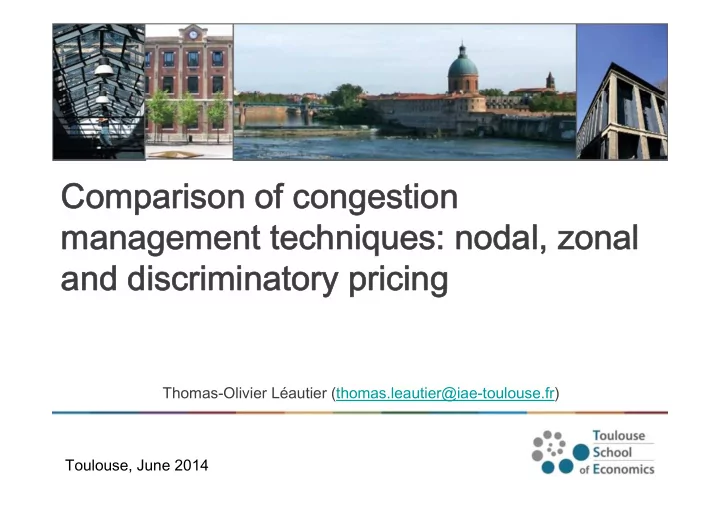

Comparison of congestion management techniques: nodal, zonal and discriminatory pricing Thomas-Olivier Léautier (thomas.leautier@iae-toulouse.fr) Toulouse, June 2014
Unconstrained dispatch c I q c E q I E p U P I q I I I E P E q U q I U q E 2
Nodal pricing c I q c E q N p I I E K I I K P I q N p E P E q N N q E q I 3
Efficiency of Nodal pricing (Proposition 1) • A market with nodal pricing has at least one Nash Equilibrium where producers offer at their marginal cost. All Nash Equilibrium result in the same locally efficient dispatch • Intuition: infinitesimally small producers cannot affect local market price 4
Efficiency of discriminatory pricing (Propositions 2 and 3) • There exist Nash equilibria in a network with discriminatory pricing. All such Nash equilibria have the following properties 1. The dispatched production is identical to the network’s efficient dispatch in each node 2. All production in node I with marginal cost at or below c i N (q i N ) is offered at the network competitive nodal price p i N =c i N (q i N ) 3. Other offers are not accepted and are not uniquely determined in equilibrium • Intuition: inframarginal producers (even infinitesimally small) can affect the price they receive 5
Counter trading c I q c E q N p I p U I I K I E K P I q N p E P E q N U U N q E q E q I q I 6
Efficiency of counter trading (Propositions 4 and 5) • There exist Nash equilibria in a zonal market with counter trading. All such Nash equilibria have the following properties 1. The dispatched production is identical to the network’s efficient dispatch in each node 2. In strictly export-constrained nodes, production with marginal cost at or above the network’s competitive nodal price p i N =c i N (q i N ) are offered at p i N 3. In stricly import-constrained nodes, all production with marginal cost at N is offered at p i or below p i N 4. Equilibrium is unchanged whether producers are allowed to update their offers in the counter-trading stage or not • Intuition: producers bid low to be dispatched in the day- ahead, and bought back in the counter-trading market 7
Inefficiency of counter trading (Corollary 2) • In comparison to nodal pricing, there is an extra payoff from the system operator to constrained off producers • Therefore, production investment will be too high in strictly export constrained nodes 8
Comments and suggestions • Important policy issue • Results are driven by assumption of infinitesimally small producers. How realistic is it? • What would happen in the presence of congestion management instruments (e.g., Financial Transmission Rights) 9
Recommend
More recommend